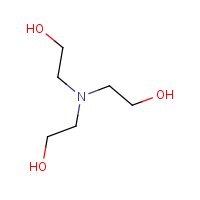Triethanolamine
Agent Name
Triethanolamine
CAS Number
102-71-6
Formula
C6-H15-N-O3
Major Category
Nitrogen Compounds

Synonyms
TEA; 2,2',2''-Nitrilotriethanol; 2,2',2''-Nitrilotris(ethanol); Alkanolamine 244; Biafine; Daltogen; Ethanol, 2,2',2'-nitrilotris-; Mobisyl; Nitrilotriethanol; Sterolamide; Sting-Kill; TEA (amino alcohol); Thiofaco T-35; Tri(hydroxyethyl)amine; Triethylamine, 2,2',2''-trihydroxy-; Triethylolamine; Trihydroxytriethylamine; Tris(2-hydroxyethyl)amine; Tris(beta-hydroxyethyl)amine; Trolamine; [ChemIDplus] 2,2',2?-Nitrilotriseth-anol; [Merck Index] Nitrilo-2,2',2"-triethanol; Tris (hydroxyethyl)amine;T-35; Nitrilotris (ethanol) [EPA - TSCATS] Tri-beta-hydroxy ethanolamine; [Fisher Scientific MSDS]
Category
Ethanolamines
Description
Highly hygroscopic, viscous liquid with a mild ammoniacal odor; Becomes brown on air and light exposure; mp = 21.57 deg C; [Merck Index] Light yellow viscous liquid; Hygroscopic; [Fisher Scientific MSDS]
Sources/Uses
Used as an intermediate for surface active agents, textile specialties, waxes, polishes, herbicides, petroleum demulsifiers, toilet goods, cement additives, cutting oils, and other chemicals, for increasing penetration of organic liquids into wood and paper, producing lubricants for textile industry, making emulsions with mineral oils, vegetable oils, paraffin, and waxes, as solvent for casein, shellac, dyes, and natural rubber, for wool scouring, as water-repellent for textiles, dispersion agent, corrosion inhibitor, softening agent, emulsifier, humectant, plasticizer, chelating agent, rubber accelerator, in amino resin adhesives formulations, to recover hydrogen sulfide from sour natural gases and sour crude petroleum, in cement production (milling process and to improve the flow and setting properties), as lubricant additive, initiator for poly triol production, and pharmaceutic aid (alkalizing agent; [HSDB] Used as an emulsifier and surfactant in various cleaning products, polishes, metalworking fluids, paints, and printing inks, and as an alkalinizing agent in personal care products; [REPROTOX] Used as stabilizer or inhibitor in pre-emergence pesticides; [ExPub: EPA - TSCATS] Used in the chemical, fuel, leather processing, paper-pulp-board, paints-lacquers-varnishes, polymers, photographic, textile processing, cosmetics, construction, extraction, refining, and processing of metals, and personal-domestic use industries; Used to make herbicides and polyurethane foam, as an anti-freeze agent, construction materials additive, corrosion inhibitor, intermediate, lubricant and additive, laboratory chemical, dustbinding agent, pH regulator, photochemical, surface-active agent, process regulator, tanning agent, vulcanizing agent, catalyst, additive in metal working fluids, in cement grinding, and gas purification; [IUCLID]
Comments
Occupational asthma and allergic contact dermatitis in machinists and photographers; [See Reference; Marks, p. 159-60] Animals sustain liver and kidney damage after high-dose feeding studies. [ACGIH] A skin, eye, and respiratory tract irritant; May cause skin sensitization; [ICSC] Low acute toxicity, with median oral LD50 values of 4,190-11,260 mg/kg in rats and 5,300-8,000 mg/kg in guinea pigs; Median dermal LD50 greater than 2,000 mg/kg in rabbits; No evidence of skin sensitization in animal studies or in a group of 64 human volunteers; Low incidence of skin sensitization reported in humans; Not carcinogenic, a developmental toxicant, or toxic to the reproductive system; [OECD SIDS] An eye irritant; May cause skin sensitization; Chronic exposure may cause liver and kidney injury; [Fisher Scientific MSDS]
Reference Link #1
Biomedical References
Exposure Assessment
Skin Designation (ACGIH)
Insufficient data
TLV (ACGIH)
5 mg/m3
MAK
1 mg/m3, inhalable fraction
Vapor Pressure
3.59E-06 mm Hg
Explanatory Notes
Flash point = 179 deg C; VP from HSDB;
Reference Link #2
NFPA
must be preheated
Adverse Effects
Skin Sensitizer
Yes
Asthma
Yes
Hepatotoxin
Hepatoxic (a) from occupational exposure (secondary effect) or (b) in animal studies or in humans after ingestion
IARC Carcinogen
Not classifiable
Diseases, Processes, and Activities Linked to This Agent
Diseases
Occupational diseases associated with exposure to this agent:
Processes
Industrial Processes with risk of exposure:
- Acid and Alkali Cleaning of Metals
- Cement Producing
- Farming (Pesticides)
- Leather Tanning and Processing
- Metal Extraction and Refining
- Metal Machining
- Painting (Pigments, Binders, and Biocides)
- Petroleum Production and Refining
- Photographic Processing
- Plastic Composites Manufacturing
- Pulp and Paper Processing
- Textiles (Fiber & Fabric Manufacturing)
- Working with Glues and Adhesives